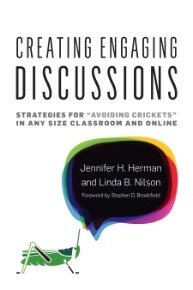teaching methods
Select an item by clicking its checkbox
Lurking on social media the other day, I listened to colleagues discussing how to respond to a student paper in a philosophy class. The assignment was about our responsibilities towards (nonhuman) animals. The student argued that we can do whatever we want with animals because God has given us dominion ...
When my first-year students write bad papers, I assume they are bad writers. If they don’t revise, I assume they don’t want to do it. If they don’t pay attention, I assume they don’t care about my course. Again and again, I assume that my students’ ...
We are early into this novel and challenging COVID semester and starting to get feedback on the (for many) new modes of teaching and learning—namely, online/virtual experiences. One message from students is that they are feeling overwhelmed with keeping up or “figuring out” the LMS or the online ...
One of the most unfortunate practices in instruction is a teacher trying to get “right answers” from students. This is not to say that getting your students to get it right is a bad thing–in fact, it’s very desirable. Usually what happens, however, is that the teacher is ...

Creating Engaging Discussions: Strategies for "Avoiding Crickets" in Any Size Classroom and Online
Date Reviewed: March 19, 2019
In the preface to their book, Herman and Nilson note that there are not many book-length treatments of discussion as a teaching method; the relative few that exist focus on student participation and are primarily oriented toward small face-to-face classrooms. Other books feature discussion as one tool among many in the teacher’s toolbox, and again focus on getting students to talk. But, as Herman and Nilson write, “Talk alone is cheap” (xxiv). The fact that students are participating in a discussion does not necessarily mean that they are actually learning. In addition to questions of participation, treatments of discussion as a way of learning also need to take into account the variety of classrooms in which students are learning: large and small, face-to-face, online, and blended. This is what Herman and Nilson set out to do.
Chapter one lays out three common challenges of discussion in both online and face-to-face classrooms: inconsistent or uneven student engagement, lack of adequate connection between course goals and discussion content or process, and lack of assessment. Chapters two and three focus on student behavior, chapter four suggests a variety of strategies for ensuring that discussions advance learning, and chapter five details ways to assess discussion both for skillful student engagement and for clear connection to course content. Chapters six through thirteen are case studies, written by a variety of practitioners and addressing a variety of discussion delivery systems (face-to-face, online, and blended) and levels (undergraduate, graduate, and professional). The final chapter, written by Herman and Nilson, provides writing prompts, discussion questions, and workshop ideas that both teachers themselves, and those charged with the professional development of teachers, could use to engage with the book’s contents.
Like many of Nilson’s previous books, this one is packed with information. As a practitioner, it is tempting to grab one or more of the discussion activities referenced in the quick guide at the front of the book and then return the book to the shelf. Doing so is a mistake precisely because of one of the ideas this book successfully advances: the need to align discussion content and process with course learning goals. This emphasis on alignment is one of my main learnings from the book, and one I will need to keep pondering and experimenting with. Each teacher must consider her course content, delivery system, institutional objectives and constraints, and student population in wisely selecting and applying discussion tactics to her particular circumstances. If I have one suggestion for the authors of this book, it might be to put the quick reference at the end to underline this point.
I will confess that when I picked up the book, I was dubious about the value of the case study chapters for my work as a theological educator. What is the relevance of collaborative autoethnography to a class on Christian worship, or of course-based scientific research to a class on Christian formation? As I continued reading, however, the case studies underlined two of Herman and Nilson’s theses: the need for and value of learning from others, even when their circumstances are different than ours, and the benefits of a deep dive into a tactic rather than a quick ransack of possible takeaways. So having finished reading the book, I plan to read it again – this time with colleagues, and over time.


